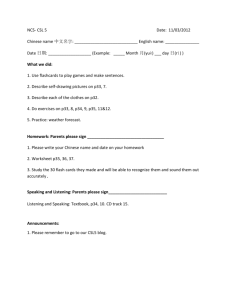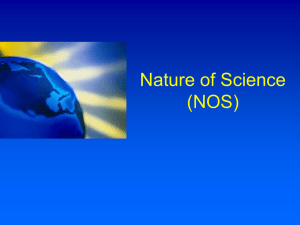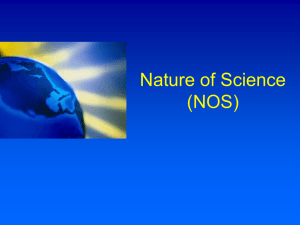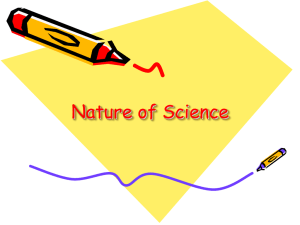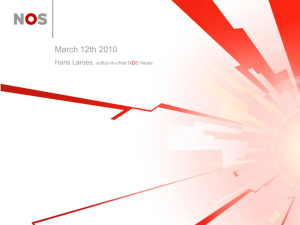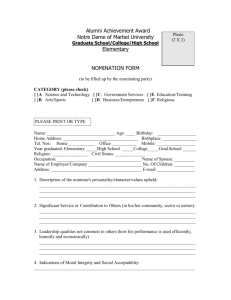The Influence of an Advanced Agriculture & Life Science Course on
advertisement
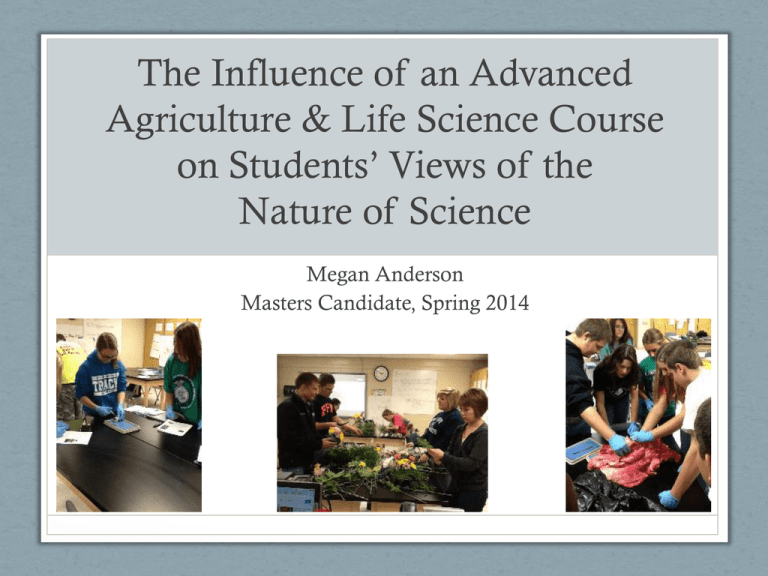
The Influence of an Advanced Agriculture & Life Science Course on Students’ Views of the Nature of Science Megan Anderson Masters Candidate, Spring 2014 Introduction • One of the goals in today’s society is to ensure that students exiting school have the ability to understand, develop, and comprehend scientific information and are becoming scientifically literate (Dogan & Ozcan, 2010; NRC, 2012). Scientific Literacy • Scientific literacy is defined as “the ability to make informed decisions on science and technology-based issues and is linked to deep understandings of scientific concepts, the processes of scientific inquiry, and the nature of science (NOS)” (Bell, Blair, Crawford, & Lederman, 2003, p. 488). • One of the fundamental components of science literacy is an adequate understanding of the nature of science (NOS) (Lederman & Zeidler, 1987). Nature of Science • The Nature of Science has been defined “as the epistemology and sociology of science, science as a way of knowing, or the values and beliefs inherent to scientific knowledge and its development” (Lederman, Abd-El-Khalick, Bell, & Schwartz, 2002). • If students do not have an adequate understanding of the NOS, they will lack the skills and understanding that are necessary to make informed decisions and contributions with regard to issues that affect lives in a rapidly changing society (Meichtry, 1992). Tenets of the NOS For K-12 students, there are seven tenets of the NOS that have gained general consensus among researchers: (Young, 2011; Melville, 2011; Khishfe, 2008; Akerson & Abd-El-Khalick, 2005; Schwartz & Lederman, 2002; Akerson, Abd-El-Khalick, and Lederman, 2000; Lederman, 1999; Abd-El-Khalick, Bell, & Lederman, 1997). Why Does NOS Matter for Agricultural Education? • Research has shown that students who are taught science through the context of agriculture demonstrate performance levels in science above or equivalent to those students in more traditional educational settings (Duncan, Ricketts, & Shultz, 2011; Ricketts, Duncan, & Peaks, 2006; Chiasson & Burnett, 2001; Enderlin & Osborne, 1992; Roegge & Russell, 1990; Whent & Leising, 1988). Why Does NOS Matter for Agricultural Education? • Citizens need to be scientifically literate so they can make informed decisions as it relates to important agriculturally related topics such as how natural resources (i.e., wind, water, etc.) should be managed (NRC, 1996). • Agriculture is one of the oldest forms of science (Ricketts, Duncan, & Peake, 2006). Need for Study • McComas (2007) determined that “increasingly widespread agreement exists that the NOS must be an integral element of the K-12 science curriculum” (p. 249). • Scientific literacy maintains strong connections with agricultural education and should be considered and further evaluated as to the benefits agricultural education can have on student science understanding. Literature Review • Many students graduating high school have inadequate views of the NOS (Lederman, 2002; Meichtry, 1993; Khishfe, 2008) and maintain misconceptions about how science actually works and functions. Literature Review • There have only been two studies completed in agricultural education in connection to the NOS. 1. Grady, Dolan, and Glasson (2013) explored scientific inquiry activities in agricultural education. • Data was collected through classroom observations, teacher discussion, and student discussion. • Students indicated Naïve conceptions of the NOS. • Teacher preservice education led to incomplete understanding of the NOS. Literature Review 2. Nortrup (2013) explored Indiana Agricultural Science & Business teachers understanding of the NOS. • • • Teachers responded through a survey that was emailed. Overall, teachers indicated views that contained inaccuracies. Most views were Naïve in NOS understanding. Literature Review • Bektas and Geban (2010) studied 162 Turkish students to understand student NOS understanding. • VNOS-C questionnaire was utilized • Interviews of a random sample of participants • Overall, student held misconceptions and deficiencies in NOS understanding. Literature Review • Millwood and Sandoval (n.d.) explored the impact of a protein synthesis modeling activity on high school student understanding of the NOS. • VNOS questionnaire was utilized • Interviews were conducted • Results indicate that students do not have informed views of the NOS which could be linked to how activities and labs in schools are portrayed. Literature Review • Fishwild (2005) examined the impact explicit instruction had on 65 high school students. • VNOS-C questionnaire was utilized. • Both groups received Newtonian Mechanics modeling instruction. • However, one group also received explicit NOS instruction while the other group served as the control. • Overall, the group that received explicit instruction made significant gains in NOS understanding, whereas the control did not achieve gains. Purpose • To explore the NOS views of students who are currently enrolled in a science-intensive agriculture course. • To explore the extent to which student views change during the course of the spring academic semester. Research Questions The research questions for this study are as follows: 1. What are agricultural science students’ initial views of the NOS before taking an advanced life science agriculture course? 2. What are agricultural science student’s views of the NOS after taking an advanced life science agriculture course? Methods & Procedures • Qualitative Single Case Study • Students in three Advanced Life Science (ALS) in Indiana participated (N=48). • Anatomy class was used as a comparison group (N=12). • Students were removed from the study if they had previously taken an ALS course. • If students were in multiple ALS courses, responses were only included once. • All students have taken Biology I and Chemistry I or Integrated, Chemistry, and Physics (ICP). Methods & Procedures • Views of the Nature of Science – Form C (VNOS-C) questionnaire was used to explore student understanding of the NOS (Lederman, Abd-El-Khalick, Bell, and Schwartz, 2002). • Ten-item open-response questionnaire. • Covers the seven tenets of the NOS important for K-12 education (Young, 2011; Melville, 2011; Abd-El-Khalick, Bell, & Lederman, 1997). Methods & Procedures • VNOS-C questionnaire was given at the beginning of the spring semester. • Stratified random sample to identify students for semi-structured interviews. • Classroom observations. • Classroom materials were collected (i.e., class handouts, worksheets, etc.) • VNOS-C questionnaire was given at the end of the spring semester. • The same students previously interviewed were interviewed again. ALS Student Participants Category Gender Agea Ethnicity General Interest in Scienceb aPercents bNot Response f % Male 22 46 Female 26 54 16 6 13 17 17 35 18 24 50 19 1 1 Caucasian 48 100 Yes 27 56 No 19 40 do not equal 100 due to rounding. all students indicated general science interest. Anatomy Student Participants Category Gender Age Ethnicitya General Interest in Scienceb aPercents bOne Response f % Male 4 33 Female 8 67 16 3 25 17 7 59 18 2 17 Caucasian 10 83 Asian American/ Other 2 16 Yes 8 67 No 3 25 are less than 100 due to rounding. student did not indicate general science interest. Data Analysis • Results were open coded by the researcher based upon examples given by Lederman, Abd-El-Khalick, Bell, and Schwartz (2002). • Students were coded into one of three categories based upon NOS understanding: 1. Naïve, 2. Emerging, or 3. Informed Findings: Research Question #1 • Examples of Naïve conceptions: • P7: Science is the idea of knowing all that there is to know about the way the universe works. Science is different from religion or philosophy because it is centered on true, unchanging facts, where as religion/philosophy is based more on beliefs and opinions. • P11: A theory is something that is not 100% sure of and known about completely. A law is something, like gravity, that has to exist for the function of other things. Scientific theory-atomic theory. • A4: I don’t think that scientists use their creativity. Scientists usually stick to the facts and data they receive to determine their questions. Findings: Research Question #1 • Examples of Emerging conceptions: • F13:I think that science is just a way of explaining and finding answers in the physical environment around us; even thoughts can be scientific if you ask me. Religion and philosophy are just other ways of explaining things, in terms of where we came from with religion and possibilities with philosophy. • A24: I think scientists may have an idea what an atom looks like, but I don’t think they know exactly what it looks like. I think the evidence they have is from knowledge from other scientists and pictures they’ve seen. • P9: Fairly certain but not 100% certain. Past is used to determine a definition, but there is no set way how the future may play out, so things may change. Findings: Research Question #1 • Examples of Informed conceptions: • P11: I think the way that science is practiced is affected by culture. Cultures do things in completely different ways. Going to the moon is an example. Not every culture has tried that yet. • F1: Yes. Theory can’t be proven true every time. Scientific law would state that it has to happen. In my opinion, law doesn’t exist in science. It only exists with math, 2+2=4 everyday, forever and ever. Newton doesn’t know if gravity will exist when we wake up tomorrow. • A12: Yes, I think some scientists do [use creativity and imagination]. At all stages they could I think. They might use their imagination to find out other things. Conclusions for Research Question #1 • Overall, students gave incomplete and Naive responses about the NOS. • The responses on the pre VNOS-C serve as a baseline in which to determine if a change in NOS conceptions did occur. Findings: Research Question #2 • Examples of Naïve conceptions: • P3: A theory is a proposed idea. A law is an idea that’s been proven. • P9: No. Scientists may use imagination in coming up with a hypothesis, but its use any farther into the experiment would deem it erroneous and inaccurate. • A11: Science is supposed to be universal so that the findings come out true. Peoples views should not get in the way of science. Findings: Research Question #2 • Examples of Emerging conceptions: • A24: I think everything pertains to science. Everyday tasks are sometimes scientific. I don’t think there is a big difference between physics and philosophy besides the way you get to the answers you need. • A21: They studied the way atoms hold together to form molecules then made conclusions based on experiments. They may not be certain but it’s a generally accepted idea that hasn’t been disproven so the scientific community accepts it as truth. • F9: Yes, theory is an educated guess, but a law is supported by data. But sometimes laws change when more stuff is discovered. Findings: Research Question #2 • Examples of Informed conceptions: • F13: I really don’t think that scientists can really prove anything, so I think there is a difference between scientific theory and scientific law. Take gravity - scientists know that it has happened time and time again, but can they absolutely prove that it will continue to happen? • F1: The different conclusions are possible because the same sets of data can be interpreted in different ways. Science is in no way solid. Interpretation of data relies almost solely on creativity and imagination. • A12: Yes, they always want to have an open mind. All [stages of investigation involve creativity and imagination]. It allows them to learn new things. Conclusions for Research Question #2 • Overall, students gave Naïve responses indicating inadequate understanding of the NOS. • However, some students with emerging conceptions gave responses that included agricultural examples such as “gravitropism” and “milk curdling.” • Students had primarily Emerging views of the tenet of Creativity and Imagination. • Predisposition to the terms “creativity and imagination’ may have occurred. • Some change was seen in understanding of social and cultural embeddedness. Implications for Practice 1. ALS curriculum improvement. 2. New agricultural education curriculum development. 3. Agricultural Science & Business (ASB) teacher preparation programs and how to integrate NOS instruction into the classroom. 4. Pre-service ASB teacher NOS preparation. Implications for Research and Theory 1. Explore the NOS to better understand student NOS understanding in relation to their enrollment in agricultural education courses. 2. Explore how science is being presented and taught in agricultural education courses. 3. Pre-service ASB teacher NOS understanding and preparation. Recommendations for Future Research 1. Explore the NOS understanding of students in other agricultural education courses. 2. Explicit instruction of the NOS needs to be examined within agricultural education. Recommendations for Future Research 3. Explore methods for explicit instruction, and which method would work best for agricultural education. 4. Science integration into agricultural education research needs to explore the NOS. Questions? Thank You
